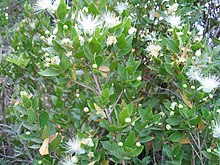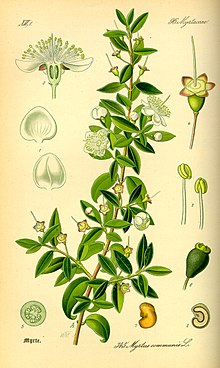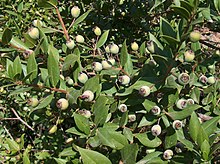Murad: Perbedaan antara revisi
JohnThorne (bicara | kontrib) ←Membuat halaman berisi '{{For|asteroid|9203 Myrtus}} {{italic title}} {{taxobox | name = ''Myrtus''<br/>Murad | image = Myrtus_communis.jpg | image_caption = ''Myrtus communis'' | image2...' |
JohnThorne (bicara | kontrib) Tidak ada ringkasan suntingan |
||
| Baris 50: | Baris 50: | ||
Several [[botanist]]s {{who|date=November 2013}} do not consider ''Myrtus nivellei'' sufficiently distinct to be treated as a separate species.{{citation needed|date=November 2013}} It is listed as an [[conservation status|endangered species]].{{citation needed|date=November 2013}} |
Several [[botanist]]s {{who|date=November 2013}} do not consider ''Myrtus nivellei'' sufficiently distinct to be treated as a separate species.{{citation needed|date=November 2013}} It is listed as an [[conservation status|endangered species]].{{citation needed|date=November 2013}} |
||
--> |
--> |
||
== |
==Penggunaan== |
||
=== |
===Pembiakan=== |
||
''Myrtus communis'', |
''Myrtus communis'', dibiakkan luas sebagai suatu [[tanaman hias]] dalam bentuk [[perdu]] di [[kebun]] dan [[taman]]. Sering menjadi tanaman pagar, di mana daun-daun kecilnya dicukur rapi. |
||
Jika lebih jarang dicukur, bunganya lebat pada akhir musim panas. Membutuhkan musim panas yang lama dan terik untuk menghasilkan bunga, dan perlu dilindungi dari ''frost'' musim dingin. |
|||
When trimmed less frequently, it has numerous flowers in late summer. It requires a long hot summer to produce its flowers, and protection from winter frosts. |
|||
Spesies dan [[subspesies]] ''M. communis'' subsp. ''tarentina'' telah memperoleh penghargaan dari [[Royal Horticultural Society]]'s [[Award of Garden Merit]].<ref>{{cite web|title=RHS Plant Selector - ''Myrtus communis''|url=http://apps.rhs.org.uk/plantselector/plant?plantid=1305|accessdate=25 May 2013}}</ref><ref>{{cite web|title=RHS Plant Selector - ''Myrtus communis'' subsp. ''tarentina''|url=http://apps.rhs.org.uk/plantselector/plant?plantid=3456|accessdate=25 May 2013}}</ref> |
|||
<!-- |
|||
===Culinary=== |
===Culinary=== |
||
''Myrtus communis'', the Common Myrtle, is used in the islands of [[Sardinia]] and [[Corsica]] to produce an aromatic liqueur called [[Mirto (drink)|''Mirto'']] by [[macerating]] it in alcohol. ''Mirto'' is one of the most typical drinks of Sardinia and comes in two varieties: ''mirto rosso'' (red) produced by macerating the berries, and ''mirto bianco'' (white) produced from the less common yellow berries and sometimes the leaves.<ref>{{cite web |
''Myrtus communis'', the Common Myrtle, is used in the islands of [[Sardinia]] and [[Corsica]] to produce an aromatic liqueur called [[Mirto (drink)|''Mirto'']] by [[macerating]] it in alcohol. ''Mirto'' is one of the most typical drinks of Sardinia and comes in two varieties: ''mirto rosso'' (red) produced by macerating the berries, and ''mirto bianco'' (white) produced from the less common yellow berries and sometimes the leaves.<ref>{{cite web |
||
| Baris 72: | Baris 73: | ||
In several countries, particularly in Europe and China, there has been a tradition for prescribing this substance for sinus infections. A systematic review of herbal medicines used for the treatment of [[rhinosinusitis]] concluded that the evidence that any herbal medicines are beneficial in the treatment of rhinosinusitis is limited, and that for ''Myrtus'' there is insufficient data to verify the significance of clinical results.<ref>{{cite journal | pmid = 17011407 | year = 2006 | last1 = Guo | first1 = R | last2 = Canter | first2 = PH | last3 = Ernst | first3 = E | title = Herbal medicines for the treatment of rhinosinusitis: A systematic review | volume = 135 | issue = 4 | pages = 496–506 | doi = 10.1016/j.otohns.2006.06.1254 | journal = Otolaryngology--head and neck surgery : official journal of American Academy of Otolaryngology-Head and Neck Surgery}}</ref> |
In several countries, particularly in Europe and China, there has been a tradition for prescribing this substance for sinus infections. A systematic review of herbal medicines used for the treatment of [[rhinosinusitis]] concluded that the evidence that any herbal medicines are beneficial in the treatment of rhinosinusitis is limited, and that for ''Myrtus'' there is insufficient data to verify the significance of clinical results.<ref>{{cite journal | pmid = 17011407 | year = 2006 | last1 = Guo | first1 = R | last2 = Canter | first2 = PH | last3 = Ernst | first3 = E | title = Herbal medicines for the treatment of rhinosinusitis: A systematic review | volume = 135 | issue = 4 | pages = 496–506 | doi = 10.1016/j.otohns.2006.06.1254 | journal = Otolaryngology--head and neck surgery : official journal of American Academy of Otolaryngology-Head and Neck Surgery}}</ref> |
||
===In myth and ritual=== |
===In myth and ritual===--> |
||
[[File:Myrtus communis4.jpg|thumb|Unripe myrtle berries of blue ("black") variety.]] |
[[File:Myrtus communis4.jpg|thumb|Unripe myrtle berries of blue ("black") variety.]] |
||
[[File:Blue myrtle berries sardinia.JPG|thumb|Ripe myrtle berries of the blue ("black") variety.]] |
[[File:Blue myrtle berries sardinia.JPG|thumb|Ripe myrtle berries of the blue ("black") variety.]] |
||
<!-- This section is linked directly in [[L. A. Ring]] - If changing the title, change the link there. --> |
<!-- This section is linked directly in [[L. A. Ring]] - If changing the title, change the link there. --><!-- |
||
;Classical |
;Classical |
||
In [[Greek mythology]] and ritual the myrtle was sacred to the goddesses [[Aphrodite]]<ref>V. Pirenne-Delforge, “Épithètes cultuelles et interpretation philosophique: à propos d’Aphrodite Ourania et Pandémos à Athènes.” ''AntCl'' ''57'' (1980::142-57) p. 413.</ref> and also [[Demeter]]: [[Artemidorus]] asserts that in interpreting dreams “a myrtle garland signifies the same as an olive garland, except that it is especially auspicious for farmers because of Demeter and for women because of Aphrodite. For the plant is sacred to both goddesses.”<ref>Artemidorus, ''Oneirocritica'', I.77. (translation of [[Hugh G. Evelyn-White]]).</ref> [[Pausanias (geographer)|Pausanias]] explains that one of the Graces in the sanctuary at [[Elis]] holds a myrtle branch because “the rose and the myrtle are sacred to Aphrodite and connected with the story of [[Adonis]], while the Graces are of all deities the nearest related to Aphrodite.” Myrtle is the garland of [[Iacchus]], according to [[Aristophanes]],<ref>Aristophanes, ''[[The Frogs]]'', the Iacchus chorus, 330ff.</ref> and of the victors at the [[Thebes, Greece|Theban]] ''Iolaea'', held in honour of the Theban hero [[Iolaus]].<ref>[[Pindar]], ''Isthmian Ode'' IV.</ref> |
In [[Greek mythology]] and ritual the myrtle was sacred to the goddesses [[Aphrodite]]<ref>V. Pirenne-Delforge, “Épithètes cultuelles et interpretation philosophique: à propos d’Aphrodite Ourania et Pandémos à Athènes.” ''AntCl'' ''57'' (1980::142-57) p. 413.</ref> and also [[Demeter]]: [[Artemidorus]] asserts that in interpreting dreams “a myrtle garland signifies the same as an olive garland, except that it is especially auspicious for farmers because of Demeter and for women because of Aphrodite. For the plant is sacred to both goddesses.”<ref>Artemidorus, ''Oneirocritica'', I.77. (translation of [[Hugh G. Evelyn-White]]).</ref> [[Pausanias (geographer)|Pausanias]] explains that one of the Graces in the sanctuary at [[Elis]] holds a myrtle branch because “the rose and the myrtle are sacred to Aphrodite and connected with the story of [[Adonis]], while the Graces are of all deities the nearest related to Aphrodite.” Myrtle is the garland of [[Iacchus]], according to [[Aristophanes]],<ref>Aristophanes, ''[[The Frogs]]'', the Iacchus chorus, 330ff.</ref> and of the victors at the [[Thebes, Greece|Theban]] ''Iolaea'', held in honour of the Theban hero [[Iolaus]].<ref>[[Pindar]], ''Isthmian Ode'' IV.</ref> |
||
Revisi per 25 Februari 2015 22.01
| Myrtus Murad | |
|---|---|

| |
| Myrtus communis | |

| |
| Murad (M. communis)[1] | |
| Klasifikasi ilmiah | |
| Kerajaan: | |
| (tanpa takson): | |
| (tanpa takson): | |
| (tanpa takson): | |
| Ordo: | |
| Famili: | |
| Genus: | Myrtus |
| Spesies tipe | |
| Myrtus communis | |
| Species | |
|
Myrtus communis L. | |
| Sinonim[4] | |
|
Myrthus Scop. | |
Myrtus, dengan nama umum murad (bahasa Inggris: myrtle) merupakan suatu genus tumbuhan bunga dalam familia Myrtaceae. Pertama kali dipaparkan oleh Linnaeus pada tahun 1753.[3]
Taksonomi
Lebih dari 600 nama pernah diusulkan termasuk ke dalam genus ini, tetapi hampir semuanya telah dipindahkan ke genus lain atau dianggap sinonim.
Genus Myrtus beranggotakan 2 spesies yang dikenal sekarang:[4]
- Myrtus communis — "Murad umum" (Common myrtle); tumbuhan asli di daerah Laut Tengah di bagian selatan Eropa.
- Myrtus nivellei — "Murad sahara" (Saharan myrtle); tumbuhan asli di Afrika Utara.
Pemerian
Murad umum
Myrtus communis, atau Murad umum (juga disebut true myrtle; "murad sejati"), merupakan tumbuhan asli di bagian utara Mediterrania (terutama di pulau Sardinia dan Corsica, di mana memiliki nama setempat murta).[5]
Murad sahara
Myrtus nivellei atau 'Murad sahara, (bahasa Tuareg: tefeltest), tumbuh endemik di pengunungan Gurun Sahara tengah.[6]
Penggunaan
Pembiakan
Myrtus communis, dibiakkan luas sebagai suatu tanaman hias dalam bentuk perdu di kebun dan taman. Sering menjadi tanaman pagar, di mana daun-daun kecilnya dicukur rapi.
Jika lebih jarang dicukur, bunganya lebat pada akhir musim panas. Membutuhkan musim panas yang lama dan terik untuk menghasilkan bunga, dan perlu dilindungi dari frost musim dingin.
Spesies dan subspesies M. communis subsp. tarentina telah memperoleh penghargaan dari Royal Horticultural Society's Award of Garden Merit.[7][8]
|date= |website= The Epicentre |publisher= |accessdate= 16 July 2014}}</ref>
Medicinal

Myrtle occupies a prominent place in the writings of Hippocrates, Pliny, Dioscorides, Galen, and the Arabian writers.[9]
In several countries, particularly in Europe and China, there has been a tradition for prescribing this substance for sinus infections. A systematic review of herbal medicines used for the treatment of rhinosinusitis concluded that the evidence that any herbal medicines are beneficial in the treatment of rhinosinusitis is limited, and that for Myrtus there is insufficient data to verify the significance of clinical results.[10]
===In myth and ritual===-->


Referensi
- ^ Ilustrasi tahun 1885 dari Prof. Dr. Otto Wilhelm Thomé "Flora von Deutschland, Österreich und der Schweiz" 1885, Gera, Jerman
- ^ lectotype designated by A.P. de Candolle, Note Myrt. 7 (1826)
- ^ a b Tropicos, Myrtus L.
- ^ a b Kew World Checklist of Selected Plant Families
- ^ Altervista Flora Italiana, Mirto comune, Myrtaceae: Myrtus communis L. termasuk foto dan peta distribusi di Eropa.
- ^ Uicnmed.org: Myrtus nivellei - Batt & Trab. - Myrtaceae . accessed 1.10.2014.
- ^ "RHS Plant Selector - Myrtus communis". Diakses tanggal 25 May 2013.
- ^ "RHS Plant Selector - Myrtus communis subsp. tarentina". Diakses tanggal 25 May 2013.
- ^ Pharmacographia Indica (1891 edition), London
- ^ Guo, R; Canter, PH; Ernst, E (2006). "Herbal medicines for the treatment of rhinosinusitis: A systematic review". Otolaryngology--head and neck surgery : official journal of American Academy of Otolaryngology-Head and Neck Surgery. 135 (4): 496–506. doi:10.1016/j.otohns.2006.06.1254. PMID 17011407.
Pranala luar
|
- Myrtle (Myrtus communis L.), from Gernot Katzer's Spice Pages
- www.myrtus-communis.de (German)
- Myrtus in Flora Europaea
- Semua regnum
- Myrtus
- Angiosperms of Metropolitan France
- Flora Mediterrania
- Flora Eropa
- Flora Afrika Utara
- Flora Sahara
- Flora Algeria
- Flora Chad
- Flora Yunani
- Flora Iran
- Flora Italia
- Flora Lebanon
- Flora Spanyol
- Matorral shrubland
- Tumbuhan obat
- Plants used in traditional African medicine
- Tumbuhan taman
- Tumbuhan tahan kering
- Bahan makanan burung
- Semak

